Unemployment in the UK
VerifiedAdded on 2020/05/28
|10
|1678
|95
AI Summary
This assignment delves into the complex issue of unemployment within the United Kingdom. It examines various contributing factors, including recession, frictional unemployment, geographical disparities, structural issues, and the impact of migration. The paper also analyzes government initiatives aimed at addressing short-term unemployment concerns, such as wage subsidies and apprenticeship programs. Finally, it highlights persistent challenges faced by ethnic minorities and the youth in securing employment opportunities.
Contribute Materials
Your contribution can guide someone’s learning journey. Share your
documents today.
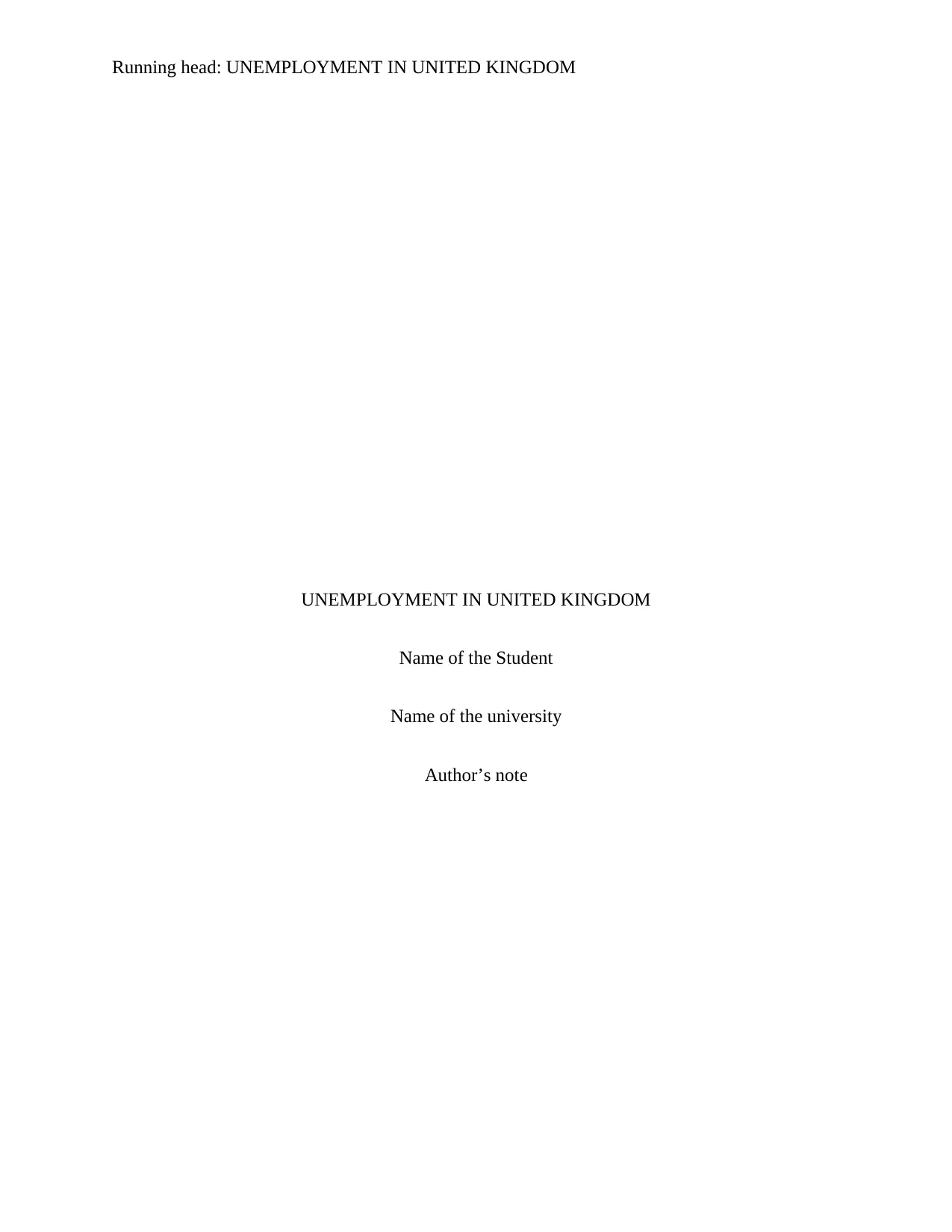
Running head: UNEMPLOYMENT IN UNITED KINGDOM
UNEMPLOYMENT IN UNITED KINGDOM
Name of the Student
Name of the university
Author’s note
UNEMPLOYMENT IN UNITED KINGDOM
Name of the Student
Name of the university
Author’s note
Secure Best Marks with AI Grader
Need help grading? Try our AI Grader for instant feedback on your assignments.
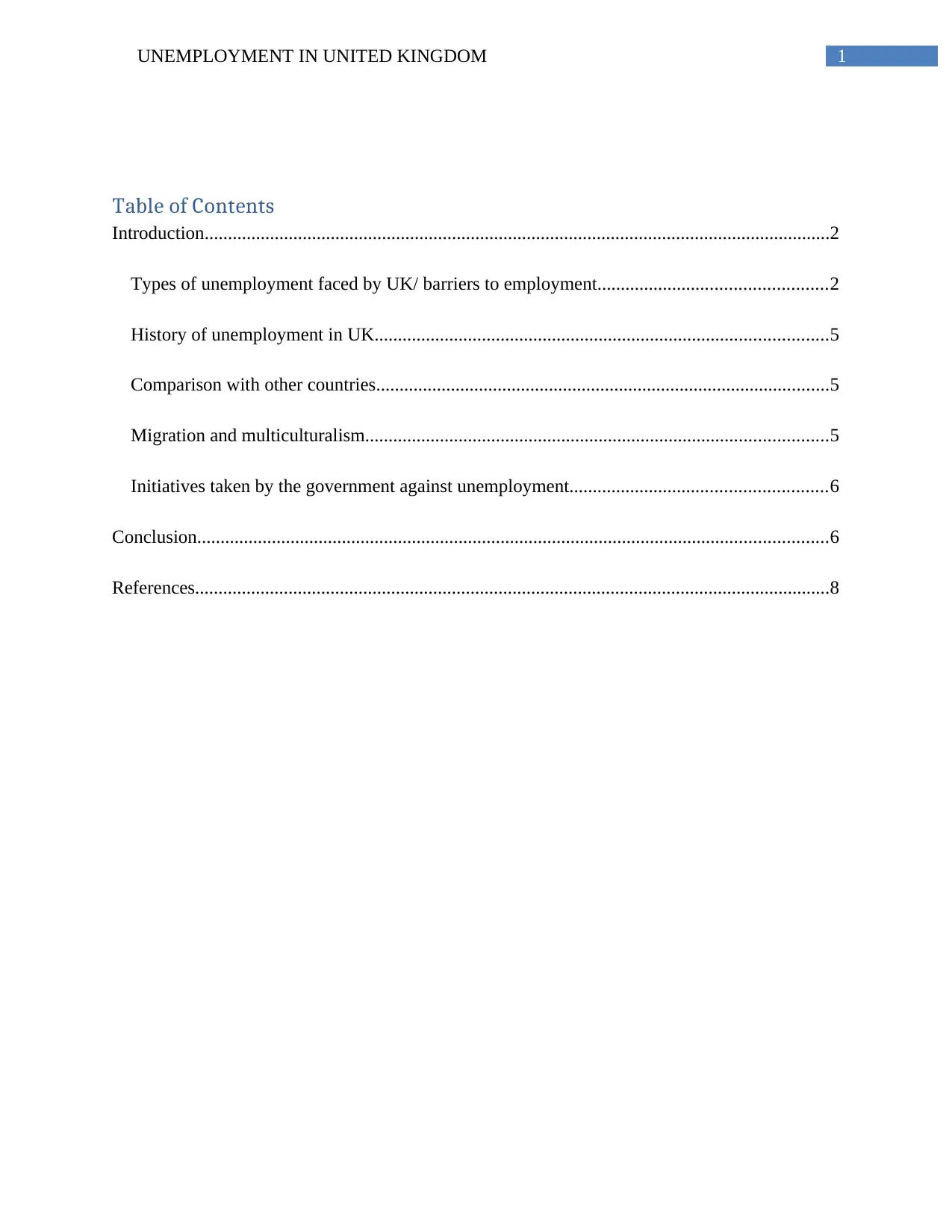
1UNEMPLOYMENT IN UNITED KINGDOM
Table of Contents
Introduction......................................................................................................................................2
Types of unemployment faced by UK/ barriers to employment.................................................2
History of unemployment in UK.................................................................................................5
Comparison with other countries.................................................................................................5
Migration and multiculturalism...................................................................................................5
Initiatives taken by the government against unemployment.......................................................6
Conclusion.......................................................................................................................................6
References........................................................................................................................................8
Table of Contents
Introduction......................................................................................................................................2
Types of unemployment faced by UK/ barriers to employment.................................................2
History of unemployment in UK.................................................................................................5
Comparison with other countries.................................................................................................5
Migration and multiculturalism...................................................................................................5
Initiatives taken by the government against unemployment.......................................................6
Conclusion.......................................................................................................................................6
References........................................................................................................................................8
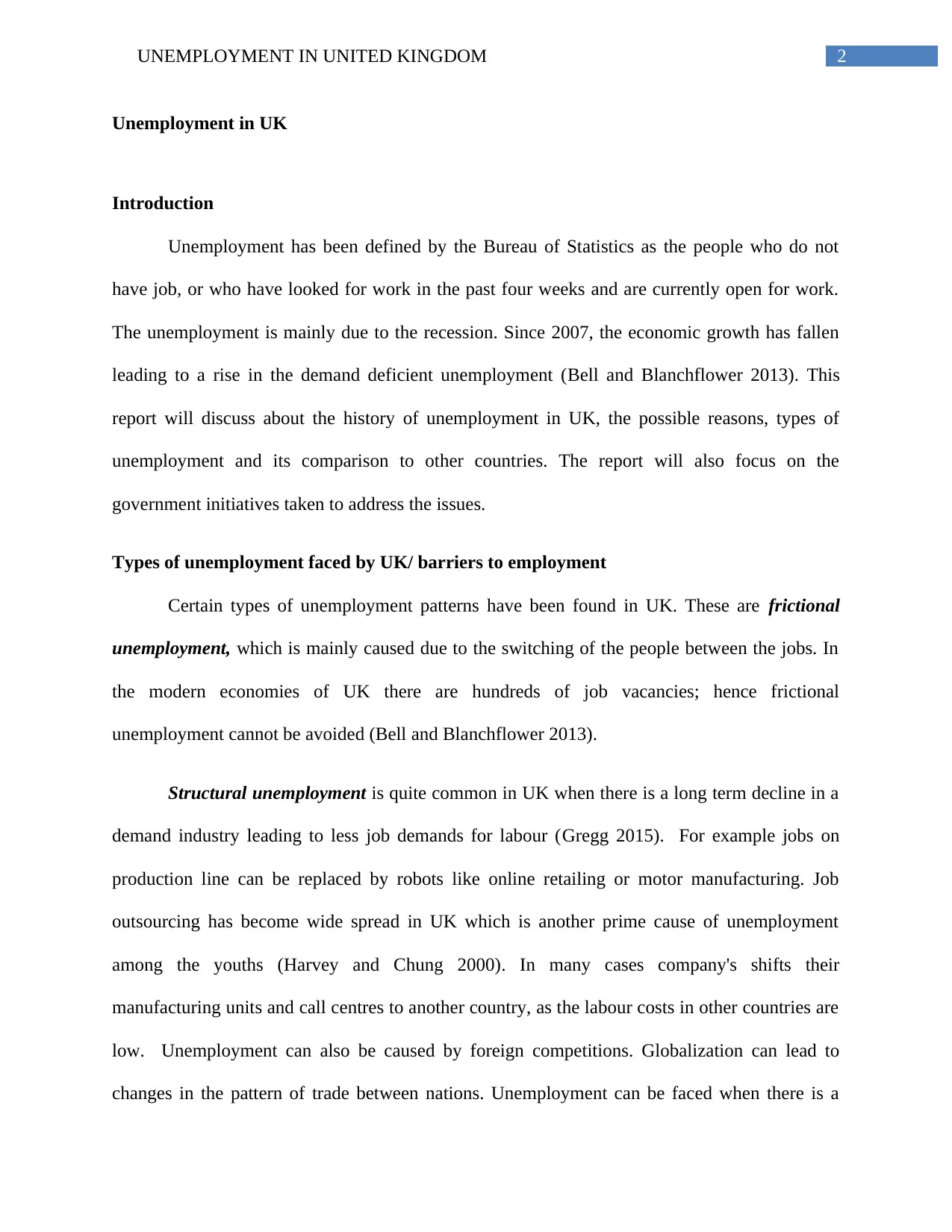
2UNEMPLOYMENT IN UNITED KINGDOM
Unemployment in UK
Introduction
Unemployment has been defined by the Bureau of Statistics as the people who do not
have job, or who have looked for work in the past four weeks and are currently open for work.
The unemployment is mainly due to the recession. Since 2007, the economic growth has fallen
leading to a rise in the demand deficient unemployment (Bell and Blanchflower 2013). This
report will discuss about the history of unemployment in UK, the possible reasons, types of
unemployment and its comparison to other countries. The report will also focus on the
government initiatives taken to address the issues.
Types of unemployment faced by UK/ barriers to employment
Certain types of unemployment patterns have been found in UK. These are frictional
unemployment, which is mainly caused due to the switching of the people between the jobs. In
the modern economies of UK there are hundreds of job vacancies; hence frictional
unemployment cannot be avoided (Bell and Blanchflower 2013).
Structural unemployment is quite common in UK when there is a long term decline in a
demand industry leading to less job demands for labour (Gregg 2015). For example jobs on
production line can be replaced by robots like online retailing or motor manufacturing. Job
outsourcing has become wide spread in UK which is another prime cause of unemployment
among the youths (Harvey and Chung 2000). In many cases company's shifts their
manufacturing units and call centres to another country, as the labour costs in other countries are
low. Unemployment can also be caused by foreign competitions. Globalization can lead to
changes in the pattern of trade between nations. Unemployment can be faced when there is a
Unemployment in UK
Introduction
Unemployment has been defined by the Bureau of Statistics as the people who do not
have job, or who have looked for work in the past four weeks and are currently open for work.
The unemployment is mainly due to the recession. Since 2007, the economic growth has fallen
leading to a rise in the demand deficient unemployment (Bell and Blanchflower 2013). This
report will discuss about the history of unemployment in UK, the possible reasons, types of
unemployment and its comparison to other countries. The report will also focus on the
government initiatives taken to address the issues.
Types of unemployment faced by UK/ barriers to employment
Certain types of unemployment patterns have been found in UK. These are frictional
unemployment, which is mainly caused due to the switching of the people between the jobs. In
the modern economies of UK there are hundreds of job vacancies; hence frictional
unemployment cannot be avoided (Bell and Blanchflower 2013).
Structural unemployment is quite common in UK when there is a long term decline in a
demand industry leading to less job demands for labour (Gregg 2015). For example jobs on
production line can be replaced by robots like online retailing or motor manufacturing. Job
outsourcing has become wide spread in UK which is another prime cause of unemployment
among the youths (Harvey and Chung 2000). In many cases company's shifts their
manufacturing units and call centres to another country, as the labour costs in other countries are
low. Unemployment can also be caused by foreign competitions. Globalization can lead to
changes in the pattern of trade between nations. Unemployment can be faced when there is a
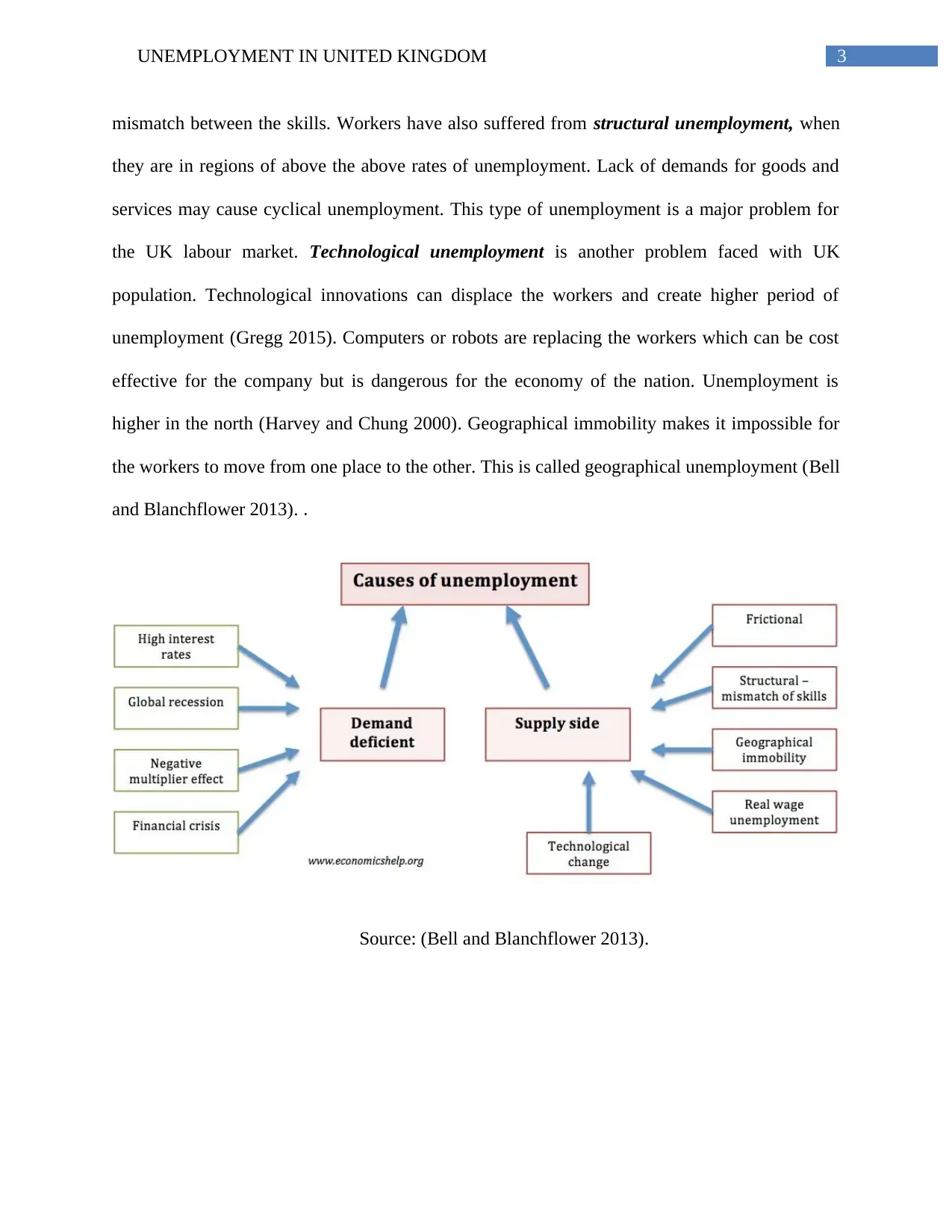
3UNEMPLOYMENT IN UNITED KINGDOM
mismatch between the skills. Workers have also suffered from structural unemployment, when
they are in regions of above the above rates of unemployment. Lack of demands for goods and
services may cause cyclical unemployment. This type of unemployment is a major problem for
the UK labour market. Technological unemployment is another problem faced with UK
population. Technological innovations can displace the workers and create higher period of
unemployment (Gregg 2015). Computers or robots are replacing the workers which can be cost
effective for the company but is dangerous for the economy of the nation. Unemployment is
higher in the north (Harvey and Chung 2000). Geographical immobility makes it impossible for
the workers to move from one place to the other. This is called geographical unemployment (Bell
and Blanchflower 2013). .
Source: (Bell and Blanchflower 2013).
mismatch between the skills. Workers have also suffered from structural unemployment, when
they are in regions of above the above rates of unemployment. Lack of demands for goods and
services may cause cyclical unemployment. This type of unemployment is a major problem for
the UK labour market. Technological unemployment is another problem faced with UK
population. Technological innovations can displace the workers and create higher period of
unemployment (Gregg 2015). Computers or robots are replacing the workers which can be cost
effective for the company but is dangerous for the economy of the nation. Unemployment is
higher in the north (Harvey and Chung 2000). Geographical immobility makes it impossible for
the workers to move from one place to the other. This is called geographical unemployment (Bell
and Blanchflower 2013). .
Source: (Bell and Blanchflower 2013).
Secure Best Marks with AI Grader
Need help grading? Try our AI Grader for instant feedback on your assignments.
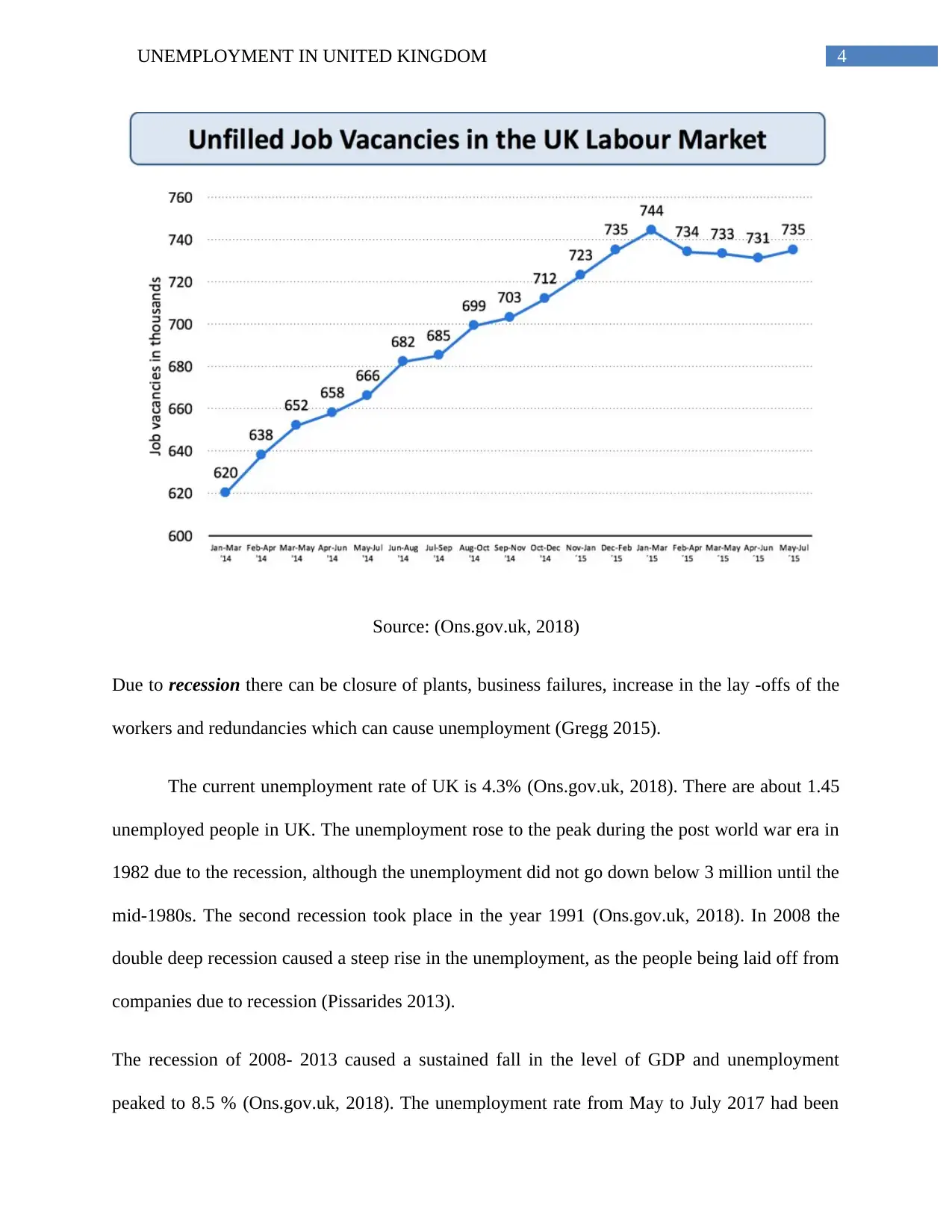
4UNEMPLOYMENT IN UNITED KINGDOM
Source: (Ons.gov.uk, 2018)
Due to recession there can be closure of plants, business failures, increase in the lay -offs of the
workers and redundancies which can cause unemployment (Gregg 2015).
The current unemployment rate of UK is 4.3% (Ons.gov.uk, 2018). There are about 1.45
unemployed people in UK. The unemployment rose to the peak during the post world war era in
1982 due to the recession, although the unemployment did not go down below 3 million until the
mid-1980s. The second recession took place in the year 1991 (Ons.gov.uk, 2018). In 2008 the
double deep recession caused a steep rise in the unemployment, as the people being laid off from
companies due to recession (Pissarides 2013).
The recession of 2008- 2013 caused a sustained fall in the level of GDP and unemployment
peaked to 8.5 % (Ons.gov.uk, 2018). The unemployment rate from May to July 2017 had been
Source: (Ons.gov.uk, 2018)
Due to recession there can be closure of plants, business failures, increase in the lay -offs of the
workers and redundancies which can cause unemployment (Gregg 2015).
The current unemployment rate of UK is 4.3% (Ons.gov.uk, 2018). There are about 1.45
unemployed people in UK. The unemployment rose to the peak during the post world war era in
1982 due to the recession, although the unemployment did not go down below 3 million until the
mid-1980s. The second recession took place in the year 1991 (Ons.gov.uk, 2018). In 2008 the
double deep recession caused a steep rise in the unemployment, as the people being laid off from
companies due to recession (Pissarides 2013).
The recession of 2008- 2013 caused a sustained fall in the level of GDP and unemployment
peaked to 8.5 % (Ons.gov.uk, 2018). The unemployment rate from May to July 2017 had been
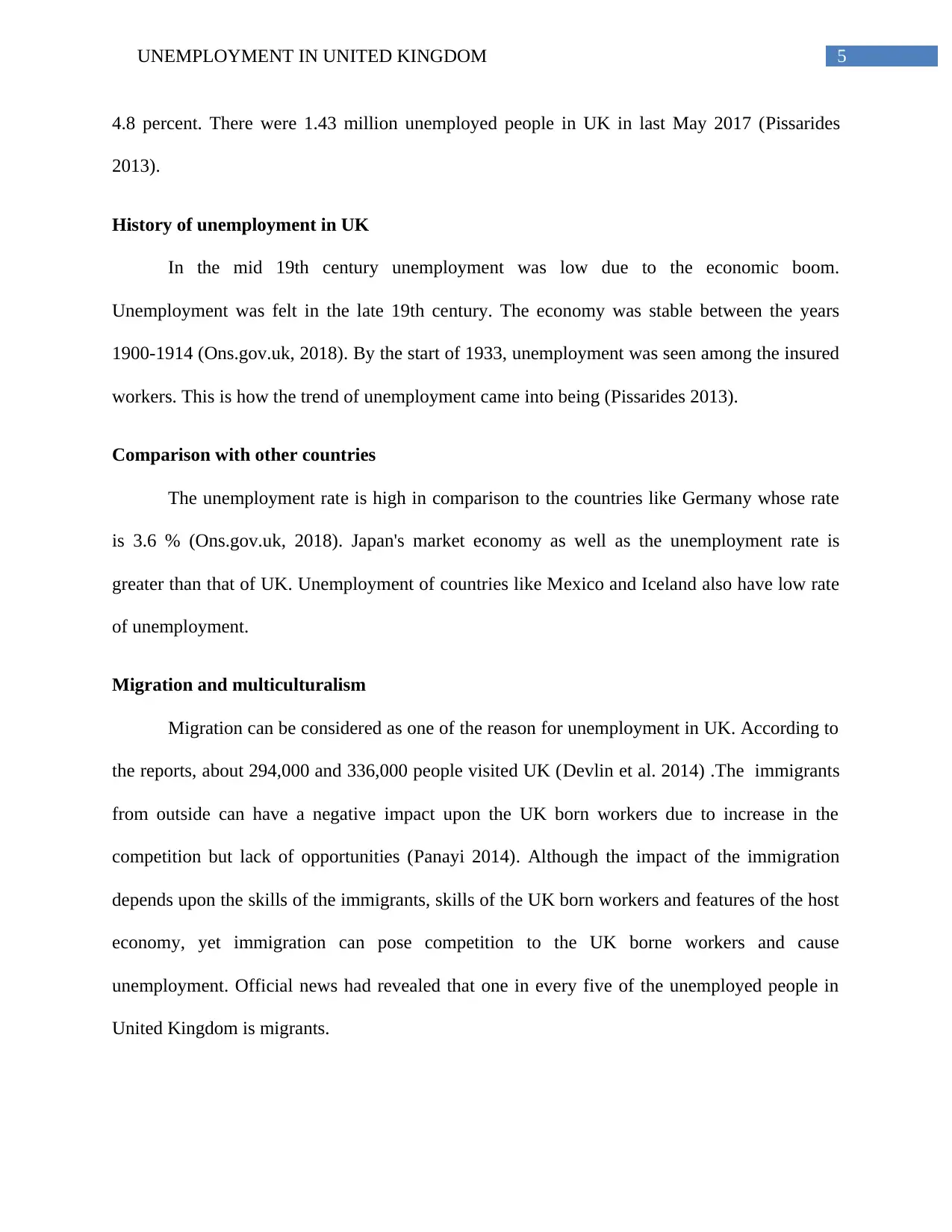
5UNEMPLOYMENT IN UNITED KINGDOM
4.8 percent. There were 1.43 million unemployed people in UK in last May 2017 (Pissarides
2013).
History of unemployment in UK
In the mid 19th century unemployment was low due to the economic boom.
Unemployment was felt in the late 19th century. The economy was stable between the years
1900-1914 (Ons.gov.uk, 2018). By the start of 1933, unemployment was seen among the insured
workers. This is how the trend of unemployment came into being (Pissarides 2013).
Comparison with other countries
The unemployment rate is high in comparison to the countries like Germany whose rate
is 3.6 % (Ons.gov.uk, 2018). Japan's market economy as well as the unemployment rate is
greater than that of UK. Unemployment of countries like Mexico and Iceland also have low rate
of unemployment.
Migration and multiculturalism
Migration can be considered as one of the reason for unemployment in UK. According to
the reports, about 294,000 and 336,000 people visited UK (Devlin et al. 2014) .The immigrants
from outside can have a negative impact upon the UK born workers due to increase in the
competition but lack of opportunities (Panayi 2014). Although the impact of the immigration
depends upon the skills of the immigrants, skills of the UK born workers and features of the host
economy, yet immigration can pose competition to the UK borne workers and cause
unemployment. Official news had revealed that one in every five of the unemployed people in
United Kingdom is migrants.
4.8 percent. There were 1.43 million unemployed people in UK in last May 2017 (Pissarides
2013).
History of unemployment in UK
In the mid 19th century unemployment was low due to the economic boom.
Unemployment was felt in the late 19th century. The economy was stable between the years
1900-1914 (Ons.gov.uk, 2018). By the start of 1933, unemployment was seen among the insured
workers. This is how the trend of unemployment came into being (Pissarides 2013).
Comparison with other countries
The unemployment rate is high in comparison to the countries like Germany whose rate
is 3.6 % (Ons.gov.uk, 2018). Japan's market economy as well as the unemployment rate is
greater than that of UK. Unemployment of countries like Mexico and Iceland also have low rate
of unemployment.
Migration and multiculturalism
Migration can be considered as one of the reason for unemployment in UK. According to
the reports, about 294,000 and 336,000 people visited UK (Devlin et al. 2014) .The immigrants
from outside can have a negative impact upon the UK born workers due to increase in the
competition but lack of opportunities (Panayi 2014). Although the impact of the immigration
depends upon the skills of the immigrants, skills of the UK born workers and features of the host
economy, yet immigration can pose competition to the UK borne workers and cause
unemployment. Official news had revealed that one in every five of the unemployed people in
United Kingdom is migrants.
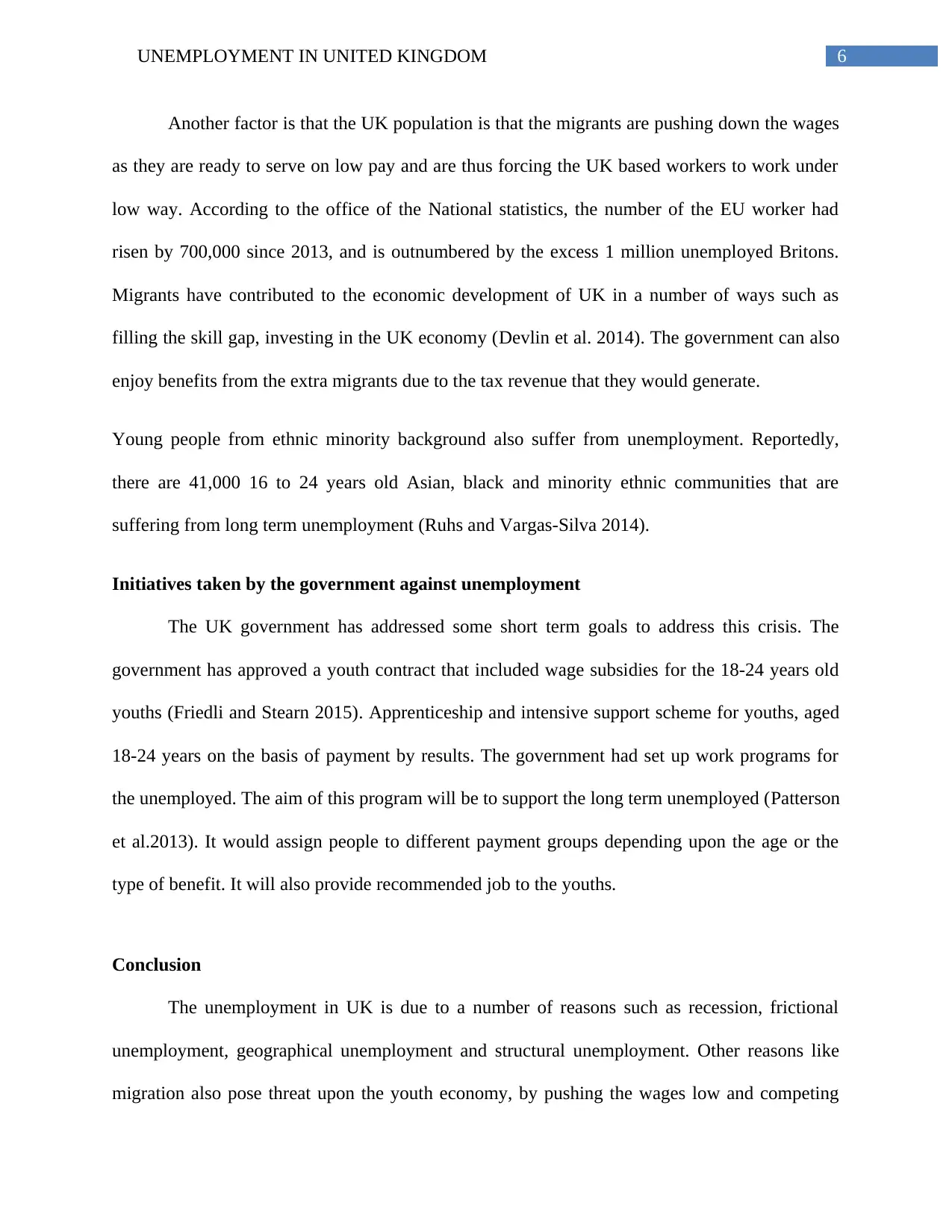
6UNEMPLOYMENT IN UNITED KINGDOM
Another factor is that the UK population is that the migrants are pushing down the wages
as they are ready to serve on low pay and are thus forcing the UK based workers to work under
low way. According to the office of the National statistics, the number of the EU worker had
risen by 700,000 since 2013, and is outnumbered by the excess 1 million unemployed Britons.
Migrants have contributed to the economic development of UK in a number of ways such as
filling the skill gap, investing in the UK economy (Devlin et al. 2014). The government can also
enjoy benefits from the extra migrants due to the tax revenue that they would generate.
Young people from ethnic minority background also suffer from unemployment. Reportedly,
there are 41,000 16 to 24 years old Asian, black and minority ethnic communities that are
suffering from long term unemployment (Ruhs and Vargas-Silva 2014).
Initiatives taken by the government against unemployment
The UK government has addressed some short term goals to address this crisis. The
government has approved a youth contract that included wage subsidies for the 18-24 years old
youths (Friedli and Stearn 2015). Apprenticeship and intensive support scheme for youths, aged
18-24 years on the basis of payment by results. The government had set up work programs for
the unemployed. The aim of this program will be to support the long term unemployed (Patterson
et al.2013). It would assign people to different payment groups depending upon the age or the
type of benefit. It will also provide recommended job to the youths.
Conclusion
The unemployment in UK is due to a number of reasons such as recession, frictional
unemployment, geographical unemployment and structural unemployment. Other reasons like
migration also pose threat upon the youth economy, by pushing the wages low and competing
Another factor is that the UK population is that the migrants are pushing down the wages
as they are ready to serve on low pay and are thus forcing the UK based workers to work under
low way. According to the office of the National statistics, the number of the EU worker had
risen by 700,000 since 2013, and is outnumbered by the excess 1 million unemployed Britons.
Migrants have contributed to the economic development of UK in a number of ways such as
filling the skill gap, investing in the UK economy (Devlin et al. 2014). The government can also
enjoy benefits from the extra migrants due to the tax revenue that they would generate.
Young people from ethnic minority background also suffer from unemployment. Reportedly,
there are 41,000 16 to 24 years old Asian, black and minority ethnic communities that are
suffering from long term unemployment (Ruhs and Vargas-Silva 2014).
Initiatives taken by the government against unemployment
The UK government has addressed some short term goals to address this crisis. The
government has approved a youth contract that included wage subsidies for the 18-24 years old
youths (Friedli and Stearn 2015). Apprenticeship and intensive support scheme for youths, aged
18-24 years on the basis of payment by results. The government had set up work programs for
the unemployed. The aim of this program will be to support the long term unemployed (Patterson
et al.2013). It would assign people to different payment groups depending upon the age or the
type of benefit. It will also provide recommended job to the youths.
Conclusion
The unemployment in UK is due to a number of reasons such as recession, frictional
unemployment, geographical unemployment and structural unemployment. Other reasons like
migration also pose threat upon the youth economy, by pushing the wages low and competing
Paraphrase This Document
Need a fresh take? Get an instant paraphrase of this document with our AI Paraphraser

7UNEMPLOYMENT IN UNITED KINGDOM
with the UK based labourers. Ethnic minorities group also shows low rates of unemployment due
racist culture, extreme competition. The current initiatives adopted by the UK government are
not enough to address the immediacy of the challenge. Specific gaps are still to be filled.
with the UK based labourers. Ethnic minorities group also shows low rates of unemployment due
racist culture, extreme competition. The current initiatives adopted by the UK government are
not enough to address the immediacy of the challenge. Specific gaps are still to be filled.
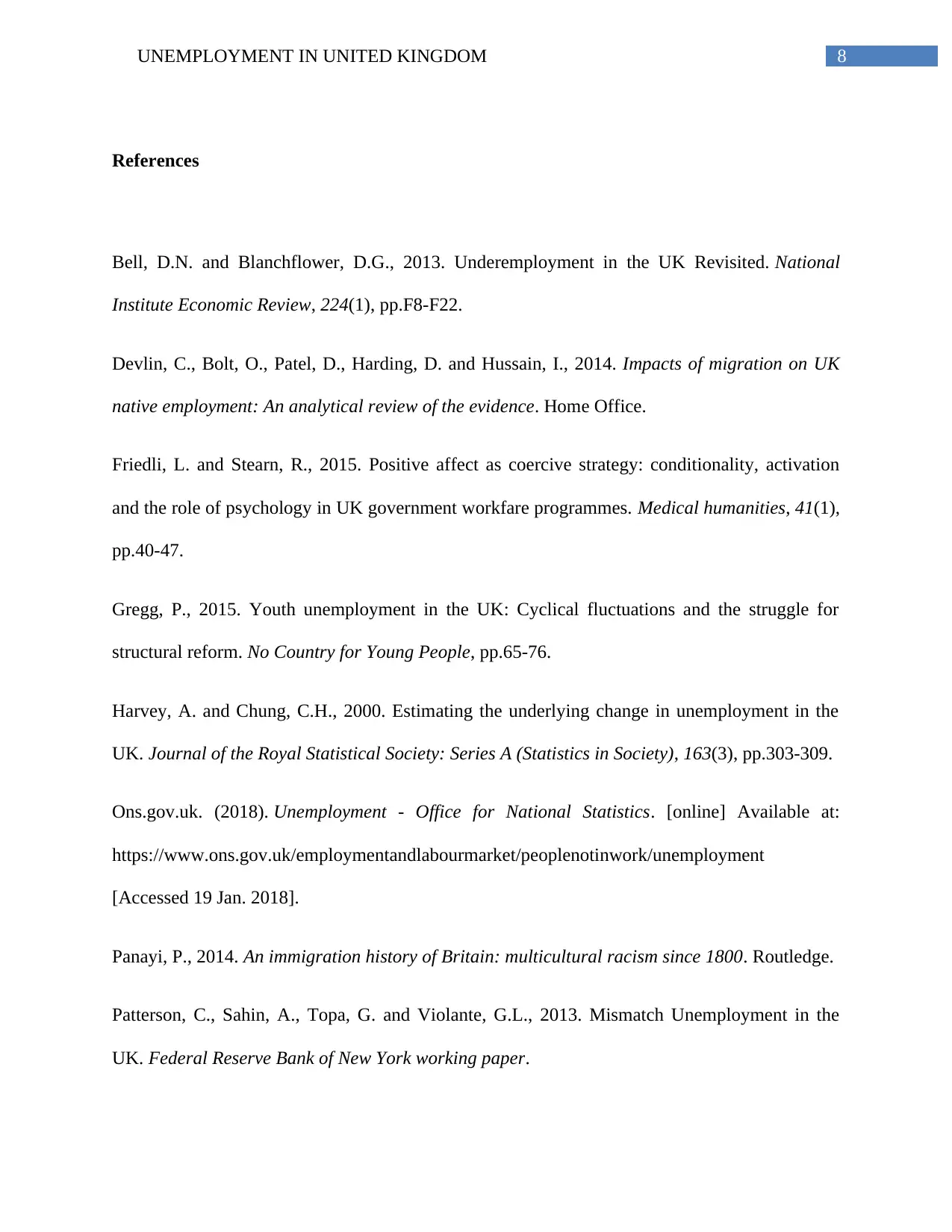
8UNEMPLOYMENT IN UNITED KINGDOM
References
Bell, D.N. and Blanchflower, D.G., 2013. Underemployment in the UK Revisited. National
Institute Economic Review, 224(1), pp.F8-F22.
Devlin, C., Bolt, O., Patel, D., Harding, D. and Hussain, I., 2014. Impacts of migration on UK
native employment: An analytical review of the evidence. Home Office.
Friedli, L. and Stearn, R., 2015. Positive affect as coercive strategy: conditionality, activation
and the role of psychology in UK government workfare programmes. Medical humanities, 41(1),
pp.40-47.
Gregg, P., 2015. Youth unemployment in the UK: Cyclical fluctuations and the struggle for
structural reform. No Country for Young People, pp.65-76.
Harvey, A. and Chung, C.H., 2000. Estimating the underlying change in unemployment in the
UK. Journal of the Royal Statistical Society: Series A (Statistics in Society), 163(3), pp.303-309.
Ons.gov.uk. (2018). Unemployment - Office for National Statistics. [online] Available at:
https://www.ons.gov.uk/employmentandlabourmarket/peoplenotinwork/unemployment
[Accessed 19 Jan. 2018].
Panayi, P., 2014. An immigration history of Britain: multicultural racism since 1800. Routledge.
Patterson, C., Sahin, A., Topa, G. and Violante, G.L., 2013. Mismatch Unemployment in the
UK. Federal Reserve Bank of New York working paper.
References
Bell, D.N. and Blanchflower, D.G., 2013. Underemployment in the UK Revisited. National
Institute Economic Review, 224(1), pp.F8-F22.
Devlin, C., Bolt, O., Patel, D., Harding, D. and Hussain, I., 2014. Impacts of migration on UK
native employment: An analytical review of the evidence. Home Office.
Friedli, L. and Stearn, R., 2015. Positive affect as coercive strategy: conditionality, activation
and the role of psychology in UK government workfare programmes. Medical humanities, 41(1),
pp.40-47.
Gregg, P., 2015. Youth unemployment in the UK: Cyclical fluctuations and the struggle for
structural reform. No Country for Young People, pp.65-76.
Harvey, A. and Chung, C.H., 2000. Estimating the underlying change in unemployment in the
UK. Journal of the Royal Statistical Society: Series A (Statistics in Society), 163(3), pp.303-309.
Ons.gov.uk. (2018). Unemployment - Office for National Statistics. [online] Available at:
https://www.ons.gov.uk/employmentandlabourmarket/peoplenotinwork/unemployment
[Accessed 19 Jan. 2018].
Panayi, P., 2014. An immigration history of Britain: multicultural racism since 1800. Routledge.
Patterson, C., Sahin, A., Topa, G. and Violante, G.L., 2013. Mismatch Unemployment in the
UK. Federal Reserve Bank of New York working paper.

9UNEMPLOYMENT IN UNITED KINGDOM
Pissarides, C.A., 2013. Unemployment in the great recession. Economica, 80(319), pp.385-403.
Ruhs, M. and Vargas-Silva, C., 2014. The labour market effects of immigration. Migration
Observatory Briefing, University of Oxford.
Pissarides, C.A., 2013. Unemployment in the great recession. Economica, 80(319), pp.385-403.
Ruhs, M. and Vargas-Silva, C., 2014. The labour market effects of immigration. Migration
Observatory Briefing, University of Oxford.
1 out of 10
Your All-in-One AI-Powered Toolkit for Academic Success.
+13062052269
info@desklib.com
Available 24*7 on WhatsApp / Email
![[object Object]](/_next/static/media/star-bottom.7253800d.svg)
Unlock your academic potential
© 2024 | Zucol Services PVT LTD | All rights reserved.




